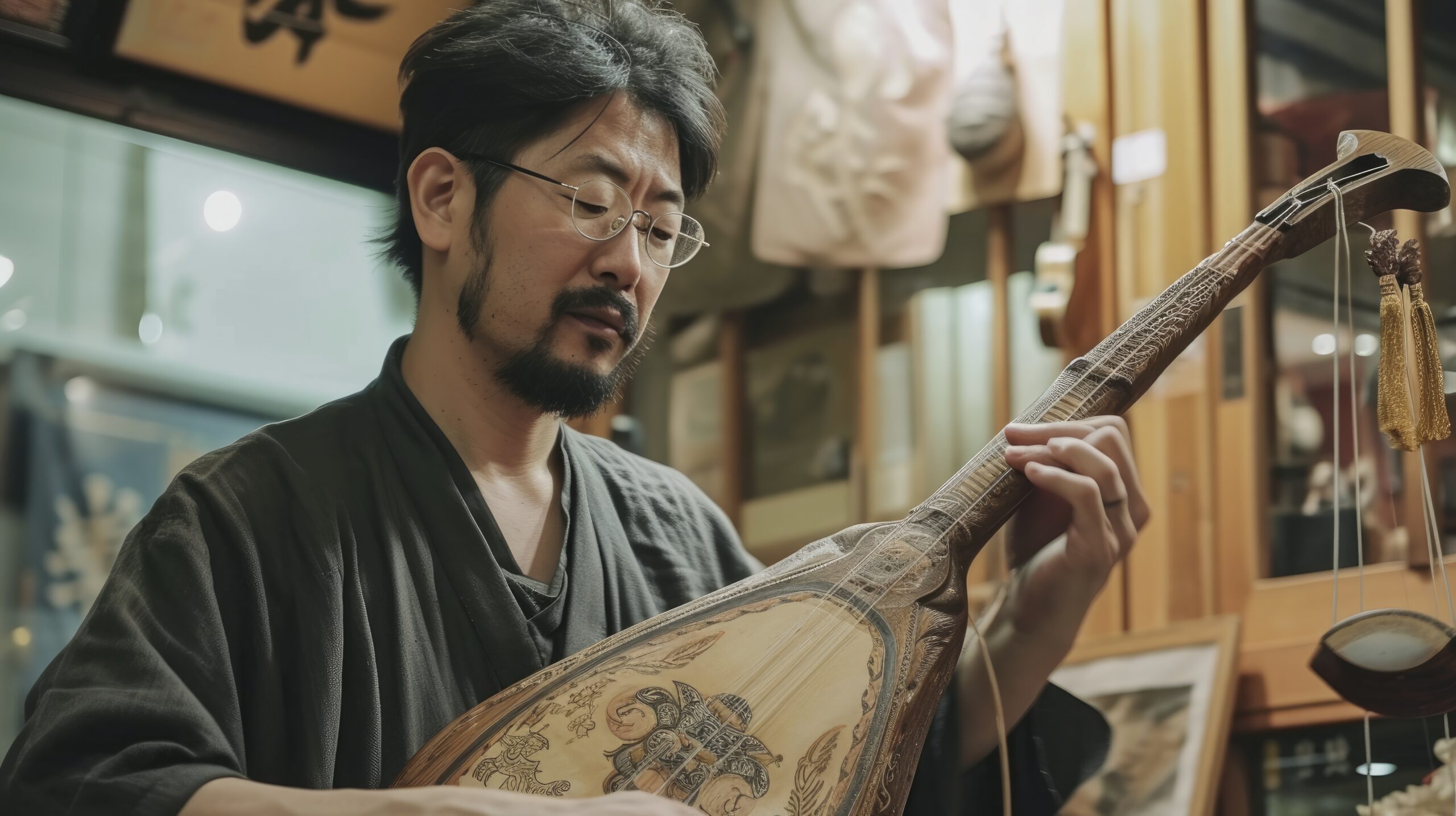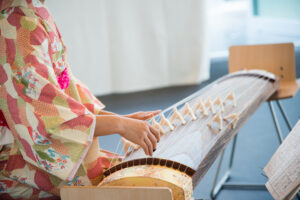In the heart of Japan’s rich cultural tapestry, the shamisen, a traditional three-stringed musical instrument, strikes a chord that resonates through the ages. Known for its distinctive sound, the shamisen has played a pivotal role in Japanese music for centuries, echoing the nation’s artistic soul. This article delves into the world of the shamisen, exploring its origins, craftsmanship, and the myriad of styles that have emerged over time. From its role in classical performances to its adaptations in modern music, the shamisen continues to captivate audiences both in Japan and around the globe. Join us on a journey through the strings of history, as we uncover the enduring legacy of Japan’s timeless stringed symphony.
Shamisen: Japan’s Timeless Stringed Symphony
The shamisen, with its evocative sound and elegant form, has long been a cornerstone of Japan’s musical heritage. This three-stringed instrument, played with a plectrum called a bachi, produces a range of tones that can convey the subtleties of human emotions, from the depths of sorrow to the heights of joy. Its presence in various forms of traditional entertainment, such as kabuki theater and geisha performances, underscores its significance in Japanese culture. The shamisen’s versatility and expressive power have allowed it to endure as a symbol of Japan’s artistic identity, captivating the hearts of both performers and audiences alike.
The Origins of Shamisen: A Musical Journey
The shamisen’s journey to Japan is a tale of cultural exchange and adaptation. Believed to have originated from the Chinese sanxian, the shamisen was introduced to Japan in the 16th century through the Ryukyu Kingdom, now known as Okinawa. This encounter marked the beginning of the shamisen’s integration into Japanese music, where it underwent significant modifications to suit local tastes and performance styles. Its adoption was swift, and it soon became a staple in traditional Japanese music, evolving into an instrument with a distinctly Japanese identity.
Crafting Sound: The Art of Shamisen Making
The construction of a shamisen is a meticulous process, reflecting the craftsmanship that Japan is renowned for. Made primarily from wood, with a skin traditionally sourced from dog or cat, the instrument’s body is designed to produce its unique sound. Today, synthetic materials are also used to cater to ethical concerns and changing preferences. The art of shamisen making is passed down through generations of craftsmen, who dedicate their lives to perfecting this craft. Each shamisen is a masterpiece, embodying the maker’s skill and the rich heritage of Japanese musical instrument making.
The Three Strings That Conquered Japan
The shamisen’s three silk strings, tuned in various intervals, are played with a large plectrum that allows for dynamic expressions. This configuration gives the shamisen its distinctive voice, capable of a wide range of pitches and tonalities. The instrument’s unique sound quickly spread across Japan, finding its place in diverse musical genres and settings. From the lively rhythms of folk music to the refined melodies of classical performances, the shamisen has proven its versatility and enduring appeal.
Shamisen Styles: From Tsugaru to Nagauta
Over time, several distinct styles of shamisen music have emerged, each with its own characteristics and repertoire. The Tsugaru style, originating from the Tsugaru region of Aomori Prefecture, is known for its vigorous and dynamic playing technique. In contrast, the Nagauta style, often associated with kabuki theater, emphasizes lyrical beauty and subtlety. Other styles, such as Jiuta and Min’yo, cater to different tastes and traditions, showcasing the shamisen’s adaptability to various musical expressions.
The Role of Shamisen in Kabuki and Bunraku
In the world of Japanese theater, the shamisen plays a crucial role in setting the emotional tone and enhancing the narrative. In kabuki, its music accompanies dramatic performances, adding depth and atmosphere to the stories portrayed on stage. Similarly, in bunraku, traditional puppet theater, the shamisen’s melodies are intertwined with the puppeteers’ movements and the chanters’ narration, creating a rich audio-visual experience. The instrument’s ability to evoke emotion and drama makes it an indispensable part of these classical art forms.
Mastering Shamisen: The Path of a Virtuoso
Becoming a shamisen virtuoso requires years of dedicated practice and deep immersion in the instrument’s traditions. Students often begin their training at a young age, learning under the guidance of a master. The path to mastery involves not only developing technical proficiency but also understanding the nuances of the various styles and the cultural context in which they evolved. For many, mastering the shamisen is a lifelong journey of continual learning and refinement.
The Evolution of Shamisen Music in Modern Japan
In recent years, the shamisen has experienced a renaissance, as artists explore new ways to incorporate its sound into contemporary music. Fusion bands and solo performers blend traditional shamisen techniques with genres like jazz, rock, and electronic music, introducing the instrument to new audiences. This innovative approach has revitalized interest in the shamisen, demonstrating its versatility and relevance in today’s music scene.
Shamisen Across Borders: Global Resonance
The allure of the shamisen extends far beyond Japan’s borders. Around the world, musicians and enthusiasts are drawn to its unique sound and expressive potential. International collaborations and performances have introduced the shamisen to global audiences, fostering cross-cultural exchange and appreciation. As the instrument travels across cultures, it continues to inspire and captivate those who encounter its timeless beauty.
Innovations in Shamisen: Fusion and Beyond
The fusion of traditional shamisen music with modern elements is not just a trend but a testament to the instrument’s adaptability. Innovations in playing techniques, compositions, and even the instrument’s design are pushing the boundaries of what the shamisen can do. These developments promise a future where the shamisen remains a vibrant and evolving part of the musical world, blending the old with the new in exciting ways.
Preserving Tradition: Shamisen in the 21st Century
As Japan navigates the balance between modernity and tradition, the shamisen stands as a symbol of cultural preservation. Efforts to maintain the instrument’s heritage, from craftsmanship to performance styles, are vital in keeping this piece of Japan’s musical identity alive. Educational programs, public performances, and cultural festivals play a critical role in ensuring that the art of the shamisen is passed on to future generations.
Shamisen Concerts: Where Tradition Meets Today
Shamisen concerts are a mesmerizing experience, where audiences can witness the fusion of centuries-old traditions with contemporary influences. These performances, ranging from intimate recitals to large-scale productions, offer a glimpse into the rich world of shamisen music. For both aficionados and newcomers, a shamisen concert is an opportunity to connect with Japan’s musical heritage and its ongoing evolution.
The shamisen, with its serene tones and dynamic versatility, continues to be a pivotal force in Japan’s musical landscape. As it bridges the past and the present, the instrument not only preserves a cherished heritage but also paves the way for future innovations. In the hands of dedicated artisans, passionate performers, and adventurous composers, the shamisen’s journey is far from over. It remains a vibrant expression of Japan’s enduring artistic spirit, striking a chord that resonates deeply in the heart of its cultural identity.






